Alaskan Malamute
Bred initially as a heavy-duty sled dog, the Alaskan Malamute is easily recognizable by its furry plumed tail, erect ears, and large size. It is a playful, affectionate, and loyal dog, making it a great companion.
The “Malamute” in their name comes from the Mahlemiut tribe of Alaska, who were the first to breed these dogs. Their thick weatherproof coats, erect ears, powerful muscles, broad shoulders, and dense bones show their heritage as Arctic dogs. They may even appear intimidating at first glance. However, their warm, brown eyes are mischievous and loving, showing their lovable nature.
Alaskan Malamute Pictures
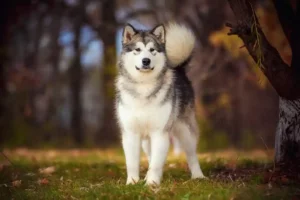
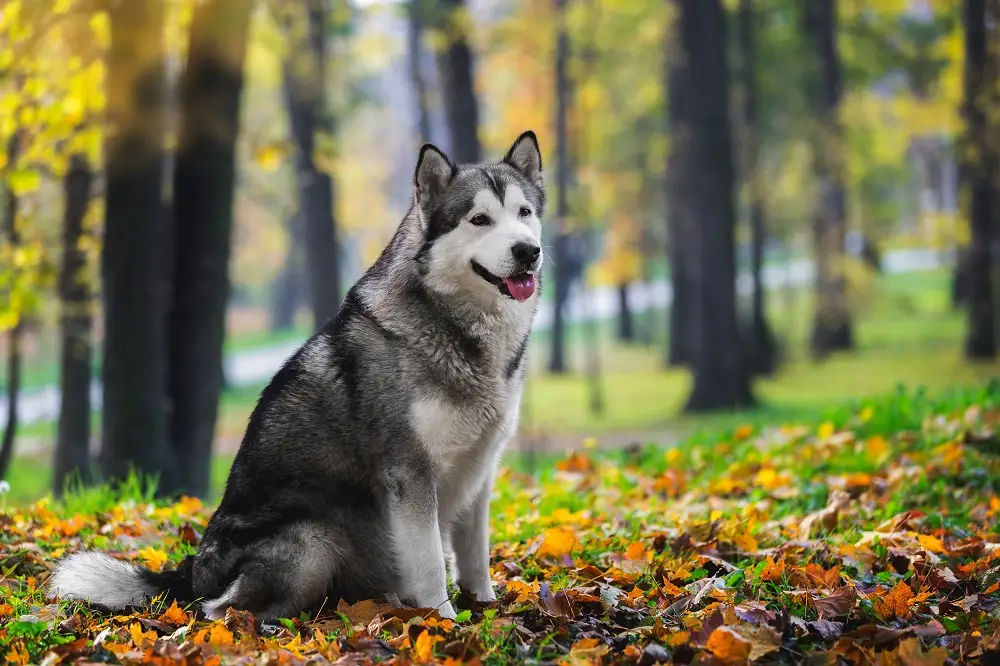
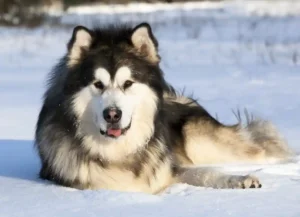
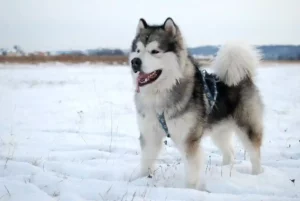

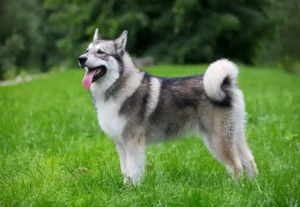
Quick Information
| Other names | Mal, Maly, Mally |
| Coat | Thick double coat with a plush undercoat |
| Color | Gray, sable, black, or red; always mixed with white |
| Breed type | Purebred |
| Group | Working dogs, Spitz |
| Life expectancy | 10-14 years |
| Size | Big |
| Height | Male – 24 – 26 inchesFemale- 22 – 24 inches |
| Weight | Male – 80 – 95 poundsFemale – 70 – 85 pounds |
| Litter Size | 4-10 puppies |
| Behavioral Characteristics | Affectionate, intelligent, playful, loyal, and independent |
| Good with children | Moderate; may injure smaller children due to their size |
| Barking Tendency | It rarely barks, instead makes loud and frequent howls with a “woo woo” sound |
| Climate compatibility | Poor; prefers cold weather |
| Apartment compatibility | Poor |
| Do they shed | Sheds frequently throughout the year, more during shedding season |
| Are they hypoallergenic | No |
| Trainability | High |
| How much do they cost | $500 – $2,500 |
| Competitive Registration Qualification / Information | AKC – American Kennel ClubAMCA – Alaskan Malamute Club of AmericaCKC – Continental Kennel ClubFCI – International Canine Federation |
| Country | United States of America |
History and Origin
The origin of the Alaskan Malamute dates back nearly four thousand years ago, making them one of the oldest breeds still in existence. While the exact origin is unknown, researchers believe their ancestors crossed the land bridge between Siberia and Alaska with their human companions. The Mahlemiut people of Northern Alaska developed them as highly prized, durable sled dogs, able to pull hefty sleds across great distances. They also used them to distract bears on hunts and sniff out seal-breathing holes in the ice. The 1896 Gold Rush caused an influx of prospectors and Malamutes were sought after, leading to crossbreeding. The native breed only survived due to the Mahlemiut’s secluded lifestyle.
The American Kennel Club gave recognition to the original Kotzebue strain in 1935. Malamutes were enlisted as search and rescue dogs and freight haulers during WWII. Unfortunately, very few survived, causing numbers to fall until only a handful were left. The American Kennel Club thus included the M’Loot and Hinman strains to save the breed. All registered Malamutes today can trace ancestry with these three strains.
Temperament and Personality
Alaskan Malamutes are incredibly friendly toward humans, so while they may look well-built and sturdy, they do not make good guard dogs. They are excellent as family dogs but require proper training before introducing them to children and smaller pets; otherwise, they might view them as prey and hunt them. They are powerful and energetic, requiring much care and upkeep, so they are recommended only for experienced owners. These adventurous dogs need large spaces to play around and do not cope well in small apartments. They are enthusiastic diggers and will readily dig up their master’s entire backyard if left unsupervised.
Being pack animals, Malamutes enjoy spending time with their master, often expressing their enthusiasm with loud howls or “woo woo” sounds. They are physically affectionate and enjoy cuddling with their owners. However, they can only stay idle for a short time and need plenty of playtime and attention. Thus, training them early in life is necessary as they are incredibly wilful and can become destructive and challenging if not properly taught.
Care
Exercise
Due to their energetic and athletic nature, Alaskan Malamutes require a lot of daily outdoor play and exercise. Activities like hiking, running, swimming, and sledding are wonderful options for you and your Malamute to enjoy together. Tricks and games are a brilliant way of providing mental exercise to your dog. Since they were bred to haul loads, competitive weight-pulling, agility, and obedience trials are great if you have the time and patience to train them.
Grooming
Alaskan Malamutes have thick and dense coats to survive Arctic winters; however, they shed a lot. Brushing daily with a pin brush and metal comb while checking for mats and fungus keeps the coat shiny. They shed twice a year, and an undercoat rake is helpful to get rid of all the clumps.
They keep themselves very clean, so you must bathe them only once every six to eight weeks. You can use conditioner if their coat feels too dry. Like most dogs, you should get their teeth brushed and nails trimmed regularly. Lastly, you must routinely check their ears for infection and clean the outer portion with a damp cotton ball.
Health Problems
The Alaskan Malamute is a hardy breed but commonly suffers from conditions like hip dysplasia, hereditary cataracts, hypothyroidism, chondrodysplasia, inherited polyneuropathy, and day blindness. They are also prone to zinc deficiencies, so supplements are advised.
Feeding
The diet should be formulated accordingly since this is a high-energy breed with daily exercise requirements. They manage well on high-quality dog food, but you should consult your veterinarian for proper guidance on the correct portion sizes and options for your Malamute. They can be at risk of getting overweight, so keep an eye on their calorie uptake.
Training
Malamutes are intelligent but playful and strong-willed, and early obedience training will ensure you have lovable, loyal, and trustworthy dogs as they grow up.
Socialization: Big dogs like Alaskan Malamutes need early socialization to grow up well-behaved and not display dominance over their master. A good way is to enroll them in a puppy kindergarten. Taking them out on walks, inviting people to your house, and visiting pet-friendly stores with them will help your Malamute get acquainted with their surroundings.
Some behaviors like digging are impossible to break, so the next best option is to have a designated area in the yard for them to dig. You should also make sure that your garden or yard is securely fenced, as they are known to run off while playing.
Obedience: Teach them to control their howling by using a gentle command like “Quiet” and rewarding them with a treat when they obey.
Leash: Since they are strong and energetic and tend to run off, you should keep your Malamute on a leash in open or public areas.
Interesting Facts
- They were declared the official state dog of Alaska in 2010.
- Besides serving in WWII, Alaskan Malamutes accompanied Admiral Richard E. Byrd on his Antarctic expedition in the early 20th century.
- They have also made appearances in movies. Director George Lucas based two beloved characters on his Alaskan Malamute “Indiana”; Indiana Jones, named after the dog, and Chewbacca from the Star Wars series.
- Many countries have featured these dogs on their official stamps, one of these being the US Postal Service stamps in 1984 to commemorate the 100th anniversary of the American Kennel Club.
FAQs
While they may appear similar, the main difference is that Alaskan Malamutes were bred for endurance and huskies for speed. So, Malamutes are bigger and heavier to pull larger loads. At the same time, huskies are smaller and slimmer, enabling them to run faster over large distances. Also, Malamutes only have brown eyes, while huskies can have brown, amber, or blue eyes.





